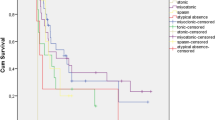Abstract
A retrospective survey on 66 adults with epilepsy who received multiple drug therapy after the failure of single drugs showed: a reduction of seizure frequency of 75% or more in 16.5%, no change in 67% and an increase in seizure frequency of 100% or more in 16.5%. Multiple drug therapy is of limited value in severe epilepsies.
Sommario
Lo studio comprende una analisi retrospettica su 66 pazienti adulti con epilessia che, dopo non aver ottenuto la scomparsa completa delle crisi con differenti monoterapie, hanno intrapreso un trattamento combinato. Nel 16,5% dei casi si è osservata, con l'introduzione della politerapia, una riduzione delle crisi del 75% ed oltre; nel 67% non si è assistito ad alcuna modificazione della frequenza critica, mentre questa è aumentata del 100% ed oltre in un altro 16,5% dei casi. La politerapia sembra essere di valore limitato nei casi di epilessia farmaco-resistente.
Similar content being viewed by others
References
McGee J.:Rapid identification and quantitative determination of barbiturates and gluthetimide in blood by gas-liquid chromatography. Clin. Chem., 17:587–591, 1971.
Reynolds E.H., Shorvon S.D.:Monotherapy or polytherapy for epilepsy?. Epilepsia, 22:1–10, 1974
Reynolds E.H., Chadwick D., Galbraith A.W.:One drug (Phenytoin) in the treatment of epilepsy. Lancet, 1:923–926, 1976
Schmidt D.:Behandlung der Epilepsien. Georg Thieme Verlag, Stuttgart, 1981
Schmidt D.:Two antiepileptic drugs for intractable epilepsy with complex partial seizures. J. Neurol. Neurosurg. Psychiatry, 45:1119–1124, 1982
Sherwin A.L., Harvey C.D., Leppik I.E.:Quantitation of antiepileptic drugs in human brain. In: P. Kellaway, I. Petersen (Eds.), Quantitative analytic studies in epilepsy, Raven Press, New York, pp 171–182, 1976.
Shorvon, S.D., Reynolds E.H.:Unnecessary polypharmacy for epilepsy. Brit. Med. J., 1:1635–1637, 1977
Shorvon S.D., Reynolds, E.H.:Reduction in polypharmacy for epilepsy. Brit. Med. J., 2:1023–1025, 1979
Shorvon S.D., Galbraith A.W., Laundy M., Vydelingum L., Reynolds E.H.:Monotherapy for epilepsy. In: S.J. Johannessen et al., (Eds.) Antiepileptic therapy: advances in drug monitoring, Raven Press, New York, pp 213–218, 1980.
Van Gelder N.M., Sherwin A.L., Rasmussen T.:Amino acid content of epileptogenic human brain focal versus surrounding regions. Brain Res., 40:385–393, 1972.
Author information
Authors and Affiliations
Rights and permissions
About this article
Cite this article
Cornaggia, C., Canevini, M.P., Giuccioli, D. et al. Monotherapy and polytherapy for intractable epilepsies. Ital J Neuro Sci 6, 201–205 (1985). https://doi.org/10.1007/BF02229193
Issue Date:
DOI: https://doi.org/10.1007/BF02229193




